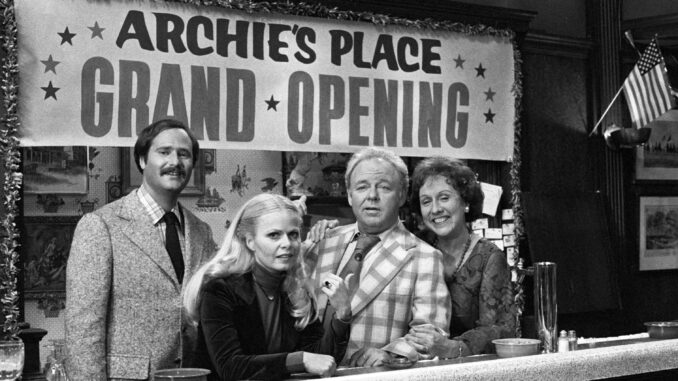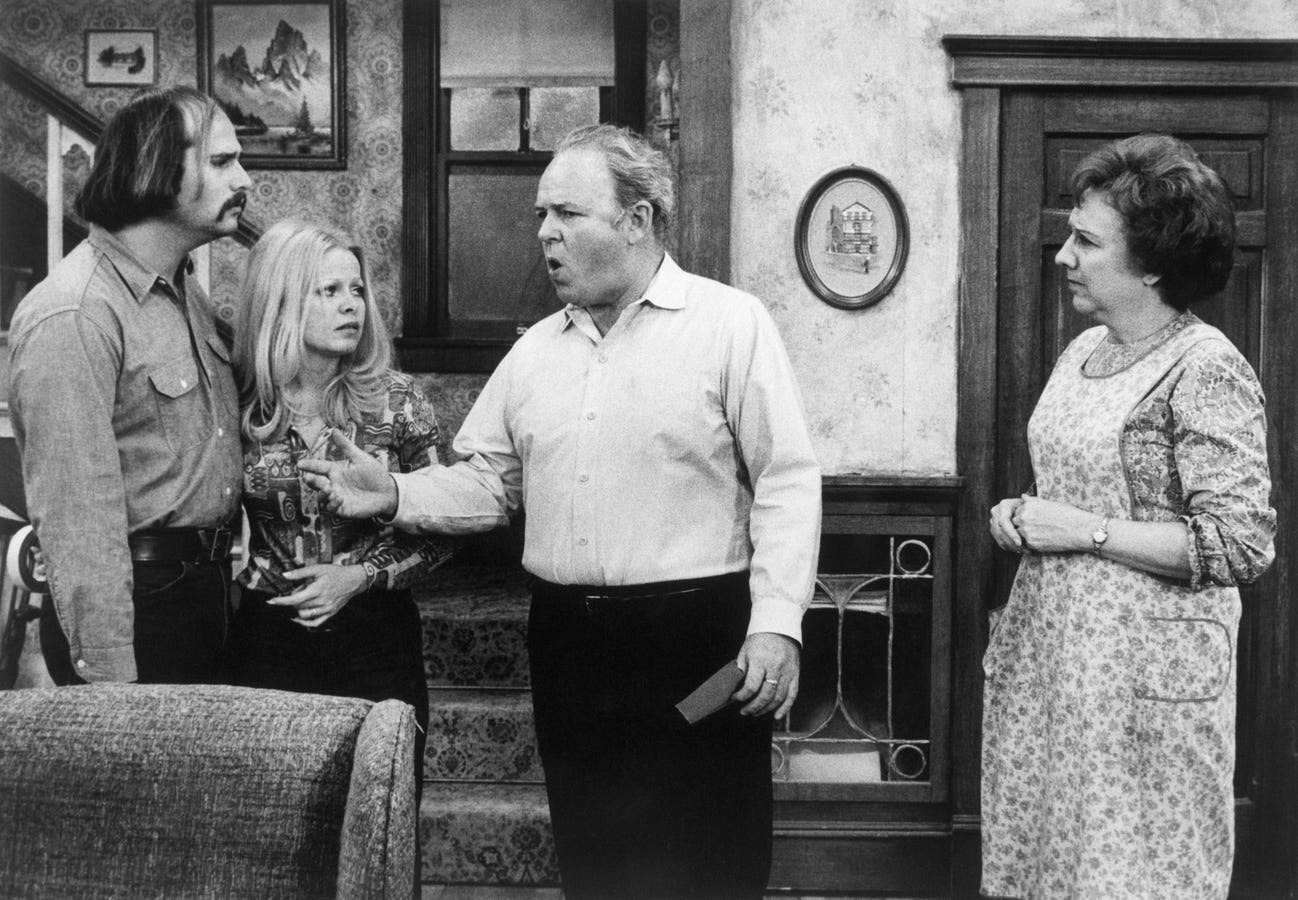
When All in the Family first aired in 1971, no one could have predicted how deeply it would change television—or how long its impact would last. Created by Norman Lear, this groundbreaking sitcom didn’t just make people laugh; it made them think.
Over five decades later, audiences still talk about the show. Its themes, characters, and fearless social commentary continue to resonate. So, does All in the Family still leave an impression today? Absolutely—and here’s why.
A Bold Beginning: How “All in the Family” Broke TV Barriers
Before All in the Family, sitcoms were simple, lighthearted, and predictable. They focused on happy families, easy laughs, and feel-good moments. Then came Archie Bunker—blunt, bigoted, and unfiltered.
Norman Lear’s creation flipped television on its head. Instead of avoiding controversial topics, the show tackled them head-on—race, gender, war, religion, and politics were all fair game. It was the first time audiences saw real-life conversations reflected on their screens.
The Heart of the Show: The Bunker Family
The magic of All in the Family came from its unforgettable characters.
-
Archie Bunker (Carroll O’Connor) – the stubborn, outspoken patriarch who represented a fading generation.
-
Edith Bunker (Jean Stapleton) – his kind-hearted but often naïve wife who balanced Archie’s roughness with warmth.
-
Gloria Stivic (Sally Struthers) – their progressive daughter who challenged her father’s old-fashioned beliefs.
-
Mike “Meathead” Stivic (Rob Reiner) – Gloria’s liberal husband who constantly clashed with Archie over politics and morality.
Their dynamic captured the essence of America in the 1970s—a nation divided, evolving, and learning to listen.
A Show Ahead of Its Time
Even now, All in the Family feels relevant. Its dialogue about racial tension, women’s rights, and generational change mirrors the same issues society faces today.
Archie Bunker wasn’t a villain—he was a reflection of millions of people struggling to adapt to a changing world. The genius of the show was that it didn’t judge him; it simply showed him as he was, flaws and all.
Comedy That Made You Think
Unlike traditional sitcoms, All in the Family didn’t rely on slapstick or gags. Its humor came from truth. Viewers laughed not because the jokes were silly, but because they hit close to home.
Every episode balanced laughter with discomfort. You might chuckle one minute, then pause the next, realizing you were confronting an uncomfortable truth about society—or yourself.
The Norman Lear Effect: Storytelling with Substance
Norman Lear revolutionized television by proving that comedy could be both funny and meaningful. He believed that TV should reflect real life, not hide from it.
Through All in the Family, Lear challenged audiences to confront their biases. He used humor as a tool for empathy, opening conversations that people were afraid to have at the dinner table.
A Mirror of Society—Then and Now

What made All in the Family so powerful was its honesty. It didn’t paint a picture of perfection; it showed life as it was. Archie represented an older generation resistant to change, while Mike and Gloria embodied the voices of progress.
Fifty years later, the same debates still play out—in politics, families, and social media. That’s why the show still feels so relevant: it reflects the timeless struggle between tradition and change.
Memorable Episodes That Still Hit Hard
Some episodes of All in the Family remain unforgettable because they pushed boundaries few dared to cross.
-
“Sammy’s Visit” featured Sammy Davis Jr., a Black entertainer, sharing a laugh—and a kiss—with Archie, breaking racial taboos on national television.
-
“Edith’s 50th Birthday” tackled the trauma of sexual assault, showing emotional depth rarely seen in sitcoms.
-
“The Draft Dodger” addressed the pain of the Vietnam War, confronting the conflict between patriotism and conscience.
These episodes didn’t just entertain—they made history.
Cultural Shockwaves: Changing How We Watch TV
Before All in the Family, television avoided controversy. After it, nothing was off-limits. Shows like The Jeffersons, Maude, and Good Times—all Lear creations—followed its lead, exploring social issues with honesty and humor.
Even modern sitcoms like The Office, Modern Family, and Black-ish owe part of their DNA to All in the Family. Its influence runs through decades of television storytelling.
Why New Generations Still Watch It
You’d think a show from the early ’70s wouldn’t connect with younger audiences—but it does. Why? Because the themes are universal.
Discussions about equality, acceptance, and generational conflict are just as relevant in 2025 as they were in 1971. In many ways, the show feels like a time capsule that still speaks to today’s world.
Sally Struthers and the Heart of Gloria
Sally Struthers’ portrayal of Gloria gave All in the Family its emotional core. She represented the voice of young women fighting for independence, respect, and equality.
Through Gloria, viewers saw the clash between old-world conservatism and modern feminism. Struthers’ performance wasn’t just acting—it was a reflection of a movement.
The Show’s Legacy on Television and Culture
Few shows have left a legacy as enduring as All in the Family. It changed what TV could be, inspiring generations of writers, directors, and performers.
Its boldness opened the door for shows like Roseanne, Married… with Children, and The Simpsons—all of which used humor to explore uncomfortable truths.
Modern Parallels: The Bunker Family in Today’s World
Imagine Archie Bunker today—scrolling through social media, arguing about politics online, and complaining about “kids these days.” He’d fit right in, wouldn’t he?
That’s the beauty of the show: the characters feel timeless. We all know an Archie, an Edith, a Gloria, and a Mike. Their conflicts mirror the same cultural battles happening right now.
Why “All in the Family” Still Matters
At its core, All in the Family wasn’t just a sitcom—it was social commentary disguised as comedy. It forced people to confront uncomfortable ideas while laughing through the tension.
That combination of humor and honesty is why it still matters. The show didn’t preach—it started conversations. And that’s what great storytelling does.
The Emotional Impact: Laughing Through the Pain
All in the Family taught audiences that laughter can heal. It showed that humor could bring people together even when they disagreed. It wasn’t afraid to expose ignorance—but it also reminded viewers that everyone, even Archie, could grow.
The Enduring Impression
Decades after its final episode, All in the Family still lingers in public memory. Its quotes, characters, and storylines remain embedded in American culture.
From reruns to streaming platforms, the show continues to attract viewers—proving that great storytelling never goes out of style.
Conclusion
So, does All in the Family still leave an impression today? Without a doubt. Its humor, honesty, and humanity continue to echo through time. The show didn’t just entertain—it educated, provoked, and inspired.
Norman Lear’s masterpiece remains a testament to the power of television to challenge, connect, and change hearts. Half a century later, All in the Family still makes us laugh, think, and reflect on who we are—and who we want to be.
